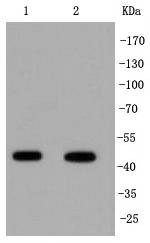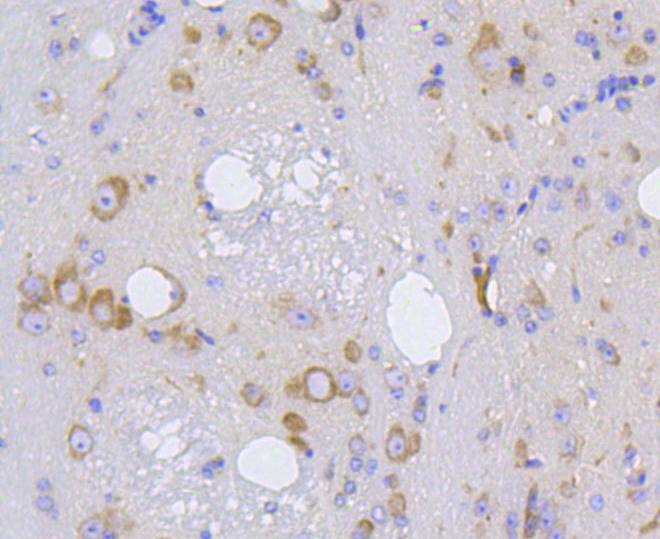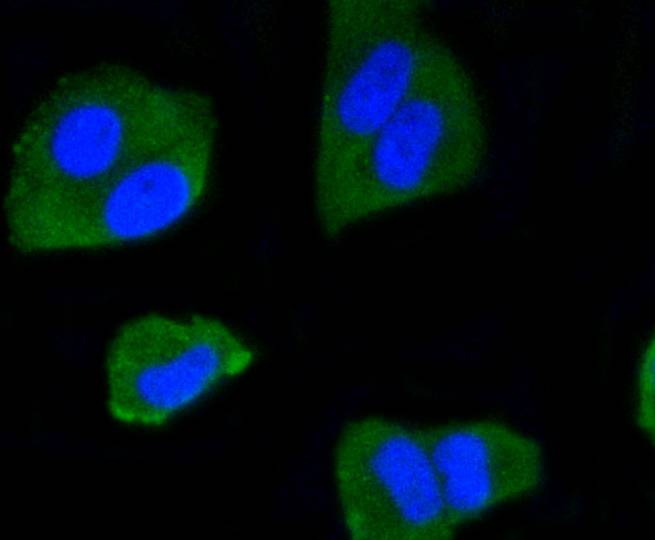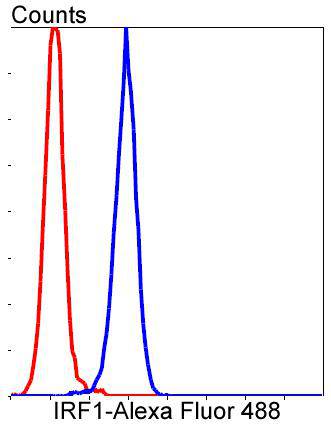Product Detail
Product NameIRF1 Rabbit mAb
Clone No.SR44-08
Host SpeciesRecombinant Rabbit
Clonality Monoclonal
PurificationProA affinity purified
ApplicationsWB, ICC/IF, IHC, IP, FC
Species ReactivityHu, Ms, Rt
Immunogen Descrecombinant protein
ConjugateUnconjugated
Other NamesInterferon regulatory factor 1 antibody
Interferon regulatory factor 1 isoform +I9 antibody
Interferon regulatory factor 1 isoform d78 antibody
Interferon regulatory factor 1 isoform delta4 antibody
Interferon regulatory factor 1 isoform delta7 antibody
IRF 1 antibody
IRF-1 antibody
IRF1 antibody
IRF1_HUMAN antibody
MAR antibody
MAR1 antibody
Accession NoSwiss-Prot#:P10914
Uniprot
P10914
Gene ID
3659;
Calculated MW48 kDa
Formulation1*TBS (pH7.4), 1%BSA, 40%Glycerol. Preservative: 0.05% Sodium Azide.
StorageStore at -20˚C
Application Details
WB: 1:1,000-1:2,000
IHC: 1:50-1:200
ICC: 1:50-1:200
FC: 1:50-1:100
Western blot analysis of IRF1 on different lysates using anti-IRF1 antibody at 1/1,000 dilution. Positive control:
Lane 1: PC-12
Lane 2: Jurkat
Immunohistochemical analysis of paraffin-embedded human colon cancer tissue using anti-IRF1 antibody. Counter stained with hematoxylin.
Immunohistochemical analysis of paraffin-embedded mouse brain tissue using anti-IRF1 antibody. Counter stained with hematoxylin.
ICC staining IRF1 in Hela cells (green). The nuclear counter stain is DAPI (blue). Cells were fixed in paraformaldehyde, permeabilised with 0.25% Triton X100/PBS.
ICC staining IRF1 in NIH/3T3 cells (green). The nuclear counter stain is DAPI (blue). Cells were fixed in paraformaldehyde, permeabilised with 0.25% Triton X100/PBS.
Flow cytometric analysis of Jurkat cells with IRF1 antibody at 1/50 dilution (blue) compared with an unlabelled control (cells without incubation with primary antibody; red). Alexa Fluor 488-conjugated goat anti rabbit IgG was used as the secondary antibody.
Interferon regulatory factor-1 (IRF-1) and IRF-2 have been identified as novel DNA-binding factors that function as regulators of both type I interferon (interferon- and ) and interferon-inducible genes. The two factors are structurally related, particularly in their N-terminal regions, which confer DNA binding specificity. In addition, both bind to the same sequence within the promoters of interferon- and interferon- genes. IRF-1 functions as an activator of interferon transcription, while IRF-2 binds to the same cis elements and represses IRF-1 action. IRF-1 and IRF-2 have been reported to act in a mutually antagonistic manner in regulating cell growth; overexpression of the repressor IRF-2 leads to cell transformation while concomitant overexpression of IRF-1 causes reversion. IRF-1 and IRF-2 are members of a larger family of DNA binding proteins that includes IRF-3, IRF-4, IRF-5, IRF-6, IRF-7, ISGF-3 p48 (a component of the ISGF-3 complex) and IFN consensus sequence-binding protein (ICSBP).
If you have published an article using product 48646, please notify us so that we can cite your literature.








 Yes
Yes



